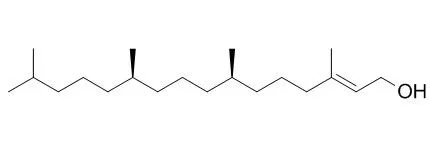| Description: |
Phytol, a diterpene alcohol from chlorophyll widely used as a food additive and in medicinal fields, shows antinociceptive, antioxidant ,anti-inflammatory, antimicrobial, antileishmanial, cytotoxicity and antiallergic effects. It is a specific activator of PPARα, it interacts with GABAA receptor, probably at the receptor subtypes that mediate benzodiazepines effects. Phytol attenuates the inflammatory response by inhibiting neutrophil migration that is partly caused by reduction in IL-1β and TNF-α levels and oxidative stress. |
| In vitro: |
| ChemMedChem. 2014 Aug;9(8):1860-8. | | Phytol derivatives as drug resistance reversal agents.[Pubmed: 24891085] | Phytol was chemically transformed into fifteen semi-synthetic derivatives, which were evaluated for their antibacterial and drug resistance reversal potential in combination with nalidixic acid against E. coli strains CA8000 and DH5α.
METHODS AND RESULTS:
The pivaloyl (4), 3,4,5-trimethoxybenzoyl (9), 2,3-dichlorobenzoyl (10), cinnamoyl (11), and aldehyde (14) derivatives of Phytol ((2E,7R,11R)-3,7,11,15-tetramethyl-2-hexadecen-1-ol) were evaluated by using another antibiotic, tetracycline, against the MDREC-KG4 clinical isolate of E. coli. Derivative 4 decreased the maximal inhibitory concentration (MIC) of the antibiotics by 16-fold, while derivatives 9, 10, 11, and 14 reduced MIC values of the antibiotics up to eightfold against the E. coli strains. Derivatives 4, 9, 10, 11, and 14 inhibited the ATP-dependent efflux pump; this was also supported by their in silico binding affinity and down-regulation of the efflux pump gene yojI, which encodes the multidrug ATP-binding cassette transporter protein.
CONCLUSIONS:
This study supports the possible use of Phytol derivatives in the development of cost-effective antibacterial combinations. | | Nat Prod Res. 2015;29(4):374-7. | | In vitro anti-quorum sensing activity of phytol.[Pubmed: 25103916] | Anti-quorum sensing activity of the diterpene Phytol was evaluated in vitro for the first time.
METHODS AND RESULTS:
This compound (at three sub-MIC concentrations - 0.5, 0.25 and 0.125 MIC, respectively) reduced the formation of Pseudomonas aeruginosa PAO1 biofilm in the range of 74.00-84.33% exhibiting higher activity than the both positive controls used, streptomycin and ampicillin. Phytol (0.5 MIC) also effectively reduced P. aeruginosa twitching and flagella motility. Indeed, the bacteria treated were incapable of producing a twitching zone and had almost round, smooth and regular colony edges. Finally, the tested compound (0.5 MIC) exhibited good P. aeruginosa pyocyanin inhibitory activity (51.94%) practically to the same extent as streptomycin (52.09%).
CONCLUSIONS:
According to the experimental data obtained, this Phytol property may inspire design of medical foods targeting P. aeruginosa quorum sensing activity. | | Biomed Res Int. 2014;2014:545038. | | HPLC-DAD analysis, antileishmanial, antiproliferative, and antibacterial activities of Lacistema pubescens: an Amazonian medicinal plant.[Pubmed: 25177694 ] | Species of the genus Lacistema are traditionally used by Brazilian and Peruvian indigenous communities.
METHODS AND RESULTS:
The present study investigated the in vitro antileishmanial activity against several Leishmania species, cytotoxicity in murine peritoneal macrophages, antiproliferative activity against HL60 and Jurkat cells, and antibacterial activities against seven bacteria strains of the aerial parts of the methanolic crude extract and fractions of Lacistema pubescens. In addition, their chemical profile was also evaluated. Hexane fraction showed the most significant IC50 values against all promastigotes of Leishmania species tested, except for L. chagasi (IC50 = 4.2 μg/mL for L. major and IC50 = 3.5 μg/mL for L. amazonensis). This fraction also exhibited a strong activity against amastigotes of L. amazonensis (IC50 = 6.9 μg/mL). The antiproliferative activity was also observed for methanolic extract and hexane fraction with IC50 = 47.2 μg/mL and IC50 = 39.7 μg/mL for HL60, respectively. Regarding the antimicrobial activity, the overall antibacterial activity was not very significative.
CONCLUSIONS:
Phytol and sitosterol were identified in the methanolic extract. Additionally, previous studies also revealed the presence of those compounds in the hexane fraction. Among other compounds, Phytol and sitosterol were probably involved in the antileishmanial and cytotoxicity activities observed in this study. |
|
| In vivo: |
| Fundam Clin Pharmacol. 2014 Aug;28(4):455-64. | | Phytol, a diterpene alcohol, inhibits the inflammatory response by reducing cytokine production and oxidative stress.[Pubmed: 24102680] | Studies have shown that diterpenes have anti-inflammatory and redox-protective pharmacological activities.
METHODS AND RESULTS:
The present study aimed to investigate the anti-inflammatory properties of Phytol, a diterpene alcohol, in a mouse model of acute inflammation, and Phytol effect on leukocyte recruitment, cytokines levels, and oxidative stress. The anti-inflammatory activities of Phytol were assessed by measuring paw edema induced by different inflammatory agents (e.g., λ-carrageenan, compound 48/80, histamine, serotonin, bradykinin, and prostaglandin E2 [PGE2 ]), myeloperoxidase (MPO) activity, peritonitis model and cytokine levels. Further, oxidative stress was evaluated by determining glutathione (GSH) levels and malondialdehyde (MDA) concentration. The results showed that Phytol (7.5, 25, 50, and 75 mg/kg) significantly reduced carrageenan-induced paw edema, in a dose-dependent manner. In addition, Phytol (75 mg/kg) inhibited compound 48/80-, histamine-, serotonin-, bradykinin- and PGE2 -induced paw edema. It also inhibited the recruitment of total leukocytes and neutrophils; decreased MPO activity, tumor necrosis factor-α (TNF-α) and interleukin-1β (IL-1β) levels, and MDA concentration; and increased GSH levels during carrageenan-induced acute inflammation.
CONCLUSIONS:
These results suggest that Phytol attenuates the inflammatory response by inhibiting neutrophil migration that is partly caused by reduction in IL-1β and TNF-α levels and oxidative stress. |
|






 Cell. 2018 Jan 11;172(1-2):249-261.e12. doi: 10.1016/j.cell.2017.12.019.IF=36.216(2019)
Cell. 2018 Jan 11;172(1-2):249-261.e12. doi: 10.1016/j.cell.2017.12.019.IF=36.216(2019) Cell Metab. 2020 Mar 3;31(3):534-548.e5. doi: 10.1016/j.cmet.2020.01.002.IF=22.415(2019)
Cell Metab. 2020 Mar 3;31(3):534-548.e5. doi: 10.1016/j.cmet.2020.01.002.IF=22.415(2019) Mol Cell. 2017 Nov 16;68(4):673-685.e6. doi: 10.1016/j.molcel.2017.10.022.IF=14.548(2019)
Mol Cell. 2017 Nov 16;68(4):673-685.e6. doi: 10.1016/j.molcel.2017.10.022.IF=14.548(2019)